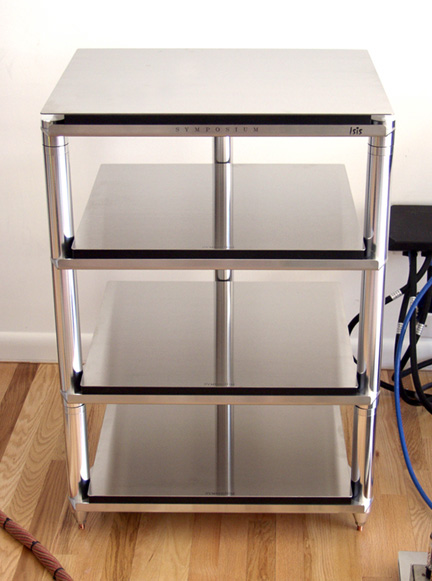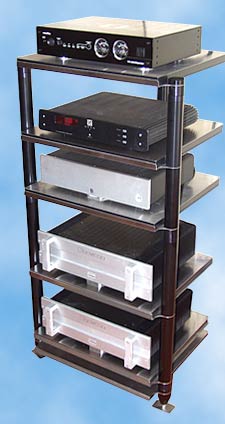SYMPOSIUM® Isis RACK SYSTEM
Review by Ernie Fisher, The Inner Ear Report vol. 15, #3

This company has been catering to "aware" consumers of audio equipment since 1994 and was incorporated in 1997. Symposium made its original market impact with a few unique devices to battle vibrations and resonances. We became acquainted with one of their products about four years ago when we reviewed their Rollerblocks (Vol 12 #1)- an interesing, very effective set of steel or tungsten balls held in a cup/well. Symposium makes use of these very effective "balls" in the construction of the Isis audio rack.
Appearance:
Unlike most ordinary shelves, the Isis strikes even casual observers as a work of competent engineering and chic physiognomy. The rack's foundation are three two-inch columns finished in flat black. These columns come in sections and provide the footing for the shelves- five of them in our example. The whole unit stands four feet high and accommodates three isolation Rollerblock Modules at its base, which suspends two of the bottom shelves. Another three Rollerblocks inserted between the second and third shelf allow them and the shelf above to "float." The top shelf is designed to hold a turntable or CD player and is floated on three additional Rollerblocks which completes the Isis' structural layout. The shelves are made from hardened foam and sheathed in stainless steel specially fabricated to deal with motion generated by the equipment. This construction fulfills a function, to be sure, but also lends the shelves a solid, professional and appealing appearance- a bit of industrial art. All visitors to our studio were throroughly impressed. The trick, however, is in the Isis'...
Technology:
Vibration control technologies abound, but it wasn't until the mid 1980's that the electronics industry began to pay specific attention. Loudspeaker manufacturers always knew that taming vibrations and resonances was of the utmost importance. Of course, vibrations originate in almost every single component we use in the electronics industry and the most audible sources are moving mechanical devices, such as CD players, turntables and tape decks. However, even cables generate vibrations and conductors resonate ever-so-slightly in unison with the dielectric material and other components. Symposium's designer Peter Bizlewicz understands all this and has developed corrective methods over a period of time resulting in many specialized devices, of which the Isis is the most recent.
The Isis is a modular rack, skillfully constructed, incorporating Rollerblock technology and dampening plates (shelves) to address the problem of primary vibrations and the resulting resonances. It can be customized to accommodate from two to five shelves, each floating on a precision-tooled steel or tungsten balls which are held in place by a magnetic field with small, yet powerful neodymium magnets, contained in the Rollerblock modules. Tungsten is offered as an option and, while the steel balls work quite effectively, tungsten will improve the rack's effectiveness by a few notches, as the material is denser than steel. The "balls" are held in place between and under the shelves with small cups, made of an aluminum alloy. There are spikes (made of aircraft aluminum) on the bottom of each column so that the entire assembled shelving system either connects directly to the floor or, when placed on carpets, can be set on optional small Point Pods for added firmness. The Point Pods are mini Symposium platforms and the "ultimate tweak" for the Isis. The spikes are reversible and can be used in a pointed or flat configuration to optimize mechanical grounding. Both methods couple the Isis firmly to the floor, while decoupling potential vibrations from the listening environment- an apparent paradox but, in reality, a sensible, tested method, often used in loudspeaker designs where spikes on enclosures fulfill the same purpose. The entire assembly is supported by three two-inch sectional columns which are made of solid aircraft aluminum.
When the Isis is fully assembled, it mimics the construction of an earthquake-proof building- it can move/sway without jeopardizing structural integrity.
The Sound:
One may well ask: "what sound?" as everyone knows that racks or shelves do not make sound. However, a shelving system contributes to the final sonic attribute, the distinctive element that makes the difference between good and great sound. For our auditioning systems, we used the Meadow Song Labs speakers (reviewed in this issue), a pair of Bryston 7B SST monoblock amplifiers (reviewed in Vol. 15 #1), a Croft amplifier (reviewed in this issue) and an Audio Aero Capitole CD player (reviewed in our last issue). All cabling was done with XLO's Limited Edition (reviewed in our last issue).
After the Isis had been assembled, we moved the Bryston 7B SST monoblocks from the floor onto the two bottom shelves. Thus, the two heavy components (about 50 pounds each) were floating on three "balls." We set the Croft amplifier onto the shelf above the Brystons, floating on three more "balls" and placed the CD player on the top shelf, isolated entirely with an additional three "balls."

Although the system sounded very impressive without the Isis, the complete system now took on further dimensions, significantly more expansive, dramatic space/time improvements, better inner detail, better focus, better bass, but more than anything, a wide open sound that seemed to have been freed from confinement. The Editor called it "uncaged," but hastened to add that uncaged here means "controlled freedom" from sonic confinement. Though we were skeptical, the Isis' effectiveness was indisputable as the all-round sound opened up and allowed listeners to hear distinct improvements. To explain this more precisely, imagine a pair of reading glasses that gradually became obsolete as the eyes change. With new prescription glasses, however, images are again in absolute focus. Though the old pair is still usable, they simply do not cut it for small print. In like manner, we were able to hear the sonic improvements attainable with the addition of this (not-so-simple) shelving system.
Synopsis & Commentary:
There are many methods to either regulate, transmit, direct or subdue vibration-causing resonances. However, almost every corrective device we have investigated fails to completely eliminate the many subtle vibrations originating from nearly all electronic components we use in a system. Vibrations and/or resonances are made up of different frequencies and include low reverberating sound ranging from bass-producing components such as loudspeakers and subwoofers right up to ultrasonic vibrations producted by tone arms, super tweeters and many moving parts. Interestingly, components that seem to be stationary and firm, such as power amplifiers and preamplifiers, also contribute their share to vibrations. It stands to reason that resonance-controlling devices can not elminate all, but should work well by modifying and/or conducting vibrations out of harm's way. Some devices will actually "gobble" vibrations or prevent them from ringing, while others will suspend, mutate or find a method to decouple vibrations before they can creep into an audio system. The Isis belongs to the latter, though dampening is also used to augment the rack's effectiveness.
Consumers of the better electronics the industry offers already know that some of the most influential elements in a system set-up are room conditions and acoustic perplexities pertaining to listening room vibrations. The room becomes a resonating environment as soon as the system is fired up. Turn up the volume and feel the walls vibrating, the floor shaking, pictures on the wall resonating along, etc. Everything resonates and, when amplified as we do in this business, some of the (unwanted) energy feeds back into the system to be amplified again, thus propagating the undesirable. The Isis is available in many configurations... [note: this review was of the very first generation Isis Rack; please consult your local dealer for current pricing of all models!]
Those who have upscale, higher fidelity sound systems will benefit from the use of any vibration control devices and/or stands; and some can cost a small fortune. However, we consider the Isis rack a cost-efficient design that offers, in addition to an aesthetic, tasteful appearance, a competent method to temper and/or remove resonating trash.
